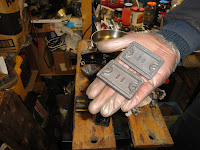I found the hydraulic system for the clutch to be heavily contaminated with a strange orange brown gunge. I suppose it is some kind of emulsion of hydraulic fluid and water because the fluid is hygroscopic (absorbs water). Whatever the cause, the effect was horrible and evident throughout, coating the inner surface of the slave cylinder, spring and piston:
Two reservoir caps are pictured because I cleaned up and lubricated the front brake master cylinder at the same time. I rubbed back the reservoir caps with a plastic alternative to wire wool made by the Scotch company and wiped them down with white spirit. After it has dried off completely, I treated the caps to a coat of Hammerite direct-to-galvanized black paint.
The master cylinder pistons for clutch and front brake are rather different. The clutch piston return spring is heavier than the one of the brake. The piston for the clutch is operated via a short rod that fits into a recess in the end of the piston and a small boss in the clutch lever. The piston for the brake is acted on directly by the front brake lever.
 |
| Master cylinder pistons for clutch (pictured left) and front brake (pictured to the right) |
The pictures below show the cleaned and reconstructed clutch master cylinder. The piston is retained by a washer and an internal circlip. It was a bit awkward replacing the circlip for the clutch - very awkward for the brake because the end of the piston is bigger so there was less room in the bore for my circlip pliers.
I'd bought a complete set of stainless steel Hel hydraulic lines for the bike. I'd asked for later spec lengths for front brake and clutch to allow for the fitting of higher handlebars, should I decide to go for a more relaxed riding position at some point.
I'd wondered how much heavier the braided lines would be than the standard rubber hoses - so I put them in an old kitched scales to find out. I was amazed to see that the Hel clutch line was actually a lot lighter than the rubber hose, despite being longer. Well well.
The clutch slave cylinder was treated to a coat of high temperature paint and the piston, return spring and hydraulic seal all carefully cleaned off ready for refitting.
The clutch lever itself had worn considerably at the pivot point. The alloy leaver has a bush pressed in to its pivot point cope with the mechanical torsion of operation. It had both worn and apparently spread into the alloy of the lever body. I've got a pattern replacement on order but would like to see if I can refurbish this one by sourcing and bronze or brass bush, drilling out the pivot point and pressing in a replacement.
















2 comments:
My clutch system was full of that orange goop to. It's stupidly pleasing to see clean components again once it's all removed.
That clutch pivot is very impressive. Never seen one that worn before.
Cheers
Great description about mechanical engineer. The reason why I liked this article is because it shared about major features about mechanical engineers and what attributes they should possess in order to give their best in the job. Thank you so much for writing this wonderful article.
Hydraulic Seal Kits
Regards
Henry Jordan
Post a Comment